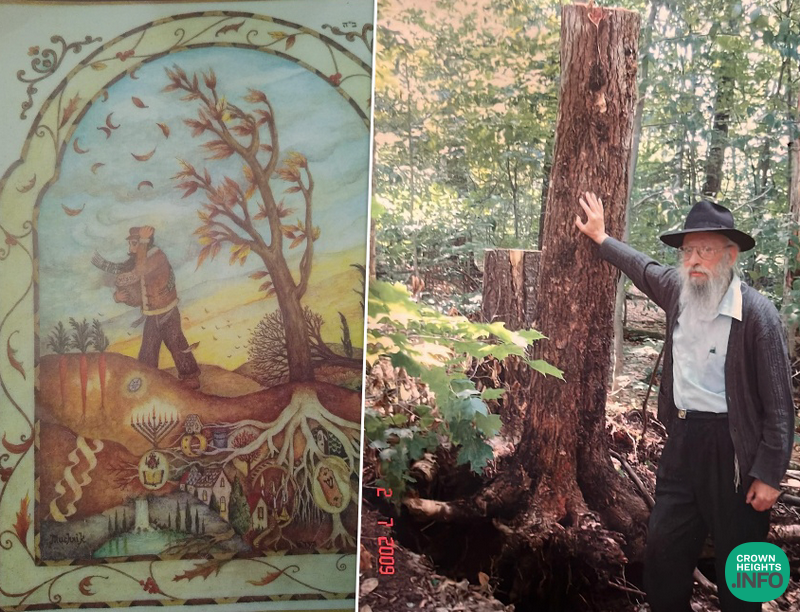
The Nine Foot Miracle Tree
Reb Nachum Goldenberg, z”l, was a beloved resident of Sainte Agathe, a Canadian town in the Laurentian Mountains about an hour from Montreal. It’s a popular summer destination, but there is a permanent shul as well, House of Israel, headed by Rabbi Emanuel and Rebbetzin Chani Carlebach.
Mr. Goldenberg’s house was partly heated by electricity and partly by an old-fashioned wood stove. In the summer, the weather was comfortable, but the winters required a healthy supply of firewood, which Mr. Goldenberg used to gather over the summer.
His routine was uncomplicated. Every morning, after studying chasidus and davening Shacharis, Mr. Goldenberg went home and ate breakfast, and then he went for a walk in the woods behind his house, looking for fallen trees.
When he saw one of suitable quality, he went back to the house to get his wheelbarrow, ax and handsaw, and he cut a cartful of firewood. He wheeled the wood back to the house and piled it up in a shed for the winter.
Although many people buy pre-cut firewood, Mr. Goldenberg enjoyed his summer walks in the forest, and he never had any trouble collecting enough wood to heat his home.
In the summer of 2009, Mr. Goldenberg went for his usual walk and found a fallen tree that had been down for a few seasons already. It had stood dozens of feet tall during its lifetime and was now ready to be cut up into logs. Mr. Goldenberg started to cut from the top of the tree and filled his wheelbarrow. He returned again and again over the next few days, cutting the tree down little by little, until about nine feet of the trunk were left.
The next time Mr. Goldenberg returned for another cartful of wood, he couldn’t find the remainder of the fallen tree. He looked and looked, but to no avail. The tree that had been lying on the ground just the day before was nowhere to be found.
He was confused. A nine-foot tree trunk cannot simply disappear overnight.
But then…after a few long minutes of searching, he saw it. The tree had been in front of him all along—but it was no longer lying on the ground. Somehow, it was standing upright again, looking as healthy and strong as all the trees around it.
The Goldenbergs did some research and discovered that this rare phenomenon is called the “tipping point.” When the tree had fallen a few years earlier, half of its roots had been torn out. But the rest had remained underground, alive and connected to their source. Lying on the ground, the tree had been weighed down by its own size. Once Reb Nachum cut off the upper branches, it became lighter, and through the roots it was able to right itself again!
Rabbi Moshe Chanowitz, a friend and neighbor of Mr. Goldenberg’s, pointed out that this phenomenon is mentioned in Iyov 14:7: “Ki yeish
The Miracle Tree la’eitz tikvah im yikareis v’od yachalif v’yonakto lo sechdal, there is hope for a tree if it is cut down that it will sprout again, and that its tender branch will not cease.” The meaning is that the tree will sprout again if it is still attached to its roots.
The Torah compares people to trees—rooted in mitzvos, tradition and family, bearing the fruits of children and maasim tovim. We flourish in the sun, surviving storms and decay. In the aftermath of failure or heartbreak, or in the wake of a national tragedy, we may feel that there is no hope, that we can only lie on the ground and wait for the end.
But as long as we remain connected to our roots, deep in the soil of our heritage, we can rise up again. All we need to do is lighten our load by shedding the emotional and mental burdens we carry and trusting in Hashem.
Today, when the Goldenberg family and their neighbors walk in the woods, they cannot find the “miracle” tree. It has continued to grow and looks just like all the other trees in the forest.
No challenge can ever spell a final end for us, whether as individuals, as a community, or as a nation. True, a strong wind can take anything down, but with strong roots, we will always rise again.












